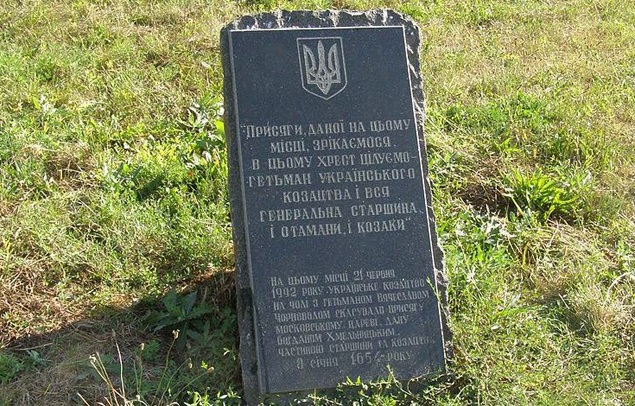Inscriptions on the Stone Plaque: “The oath was taken at this place, we renounce it. And kiss the Holy Cross to confirm this. The Hetman of the Ukrainian Cossacks, and all the Cossack general officers, and the otamans, and the Cossacks”. “At this place, on the 21th of June in 1992 year of our Lord, the Ukrainian Cossacks headed by Viacheslav Chernovil renounced the oath to the Moscow tsar, vowed by Bohdan Khmelnytsky, and the part of the Cossack officers, and the Cossacks on the 8th of January in 1654 year of our Lord”.
More than 300 years, the Muscovites (the Russians) have been interpreting the historic event of the Pereiaslav Rada (Council) concluded in 1654 as the climax in the Ukrainian’s many century pursuing of reunification with the Russians.
In 1954, they arranged the national celebration of what is known as 300-year anniversary of reunification with the purpose to show off the “eternal” friendship of the Russians and the Ukrainians. At that time, the administrative subordination of Crimean Oblast was transferred from the Russian Soviet Republic to the Ukrainian Soviet Republic as the evidence of this eternal friendship.
Concerning the word “reunification”, it also worth mentioning that only those territories can reunify which have been separated once as it happened, for instance, to West and East Germany in 1990. The Zaporozhian Host (Hetmanate) and Muscovy (Moscovia) had never been the whole unity therefore they could not be reunified. However, there were the historic times before Muscovy state establishment, when the lands of Zalissia, which much later were included into Russia, had been controlled by the Kievan Rus and incorporated into Rus (Kievan Rus), but it is pointless to regard this fact as the starting point of the united existence for the two states. Rus was the medieval state with the centre of Kyiv while Zalissia (the central Russia nowadays) was the land where the tribes of the Merya, the Muroma and the Moksha (the Mordvins) lived but were conquered and colonised by Rus. This example is similar to the situation with Gallia (Gaul) which was the province of the Roman Empire and nowadays, France is located at those lands, but it does not mean that contemporary France and contemporary Italy are the parts of one state.
Note, the Pereiaslav Treaty said it was Hetmanate that concluded the union. However, Hetmanate does not stand for all the Ukrainian land as the former did not include Volyn (Volhynia), Halytsia (Galicia), Bukovyna, Zakarpattia, Taurica, Bugeac, the South-Eastern Ukraine.
The great symbolism could be found in the place where the Pereiaslav Rada (Council) for the treaty to conclude was carried out. Pereiaslav was one of the regiment cities (polk system of administrative subdivision). Thus, the Cossack nobility’s choice for Rada to conduct was neither the capital of that time (Chyhyryn) nor the sacred centre of Ukraine (Kyiv). It means that those who were concluding that Pereiaslav Treaty did not see anything epoch-making or ever-lasting for the memory in the event of the Treaty, but it was purely of practical need.
Further, the Pereiaslav Treaty could not be recognised as the legal act from the standpoint of the Cossack tradition of that time since for that Rada there should have been present the representatives of the following regiments (polk): Каlnyk Regiment, Uman Regiment, Pavoloch Regiment, the Regiment of the Zaporozhian Host nyzovoho (river downstream). Bohdan Khmelnytsky deliberately left this omission in order to recognise the treaty illegal if required. The decision of the Rada was not supported either by Ivan Bohun or by Sylvester Kosiv, the Kyiv Metropolitan.
Furthermore, the Sides did not sign any documents. Only in March 1654, the Ukrainian ambassadors, Samiilo Zarudnyi and Pavlo Teteria, signed so-called the March Articles, the original of which was not preserved. These Articles were not discussed with the General Cossack Rada therefore they were not ratified as it was required.
The anticipated aims of the Pereiaslav Rada, as Bohdan Khmelnytsky thought of them, were to create the coalition to win against Rzeczpospolita and to acquire the international recognition for Hetmanate. Since the Ukrainian state restoration was performed by the new nobility they could not apply to the principle of old custom and could not resist to the ruler who violated the conditions of the Treaty. The way out of this situation for the newly born Cossack State was to start being recognised by any other state of Christian faith. It was the way which the Netherlands took when they managed to break away from the Spanish Сrown and were searching the protection of France and England in 1584-1585.
The Pereiaslav Treaty and the March Articles became the agreement between two states, according to which Hetmanate recognised the protection of the Moscow tsar voluntarily, but remained sovereign and had the right for the foreign relations.
An important issue in understanding the Pereiaslav Treaty are the following facts. In 1656, the Moscow state concluded Truce of Vilna with Rzeczpospolita. This meant that the Moscow tsar de jure denounced the Pereiaslav Treaty, which was the promise to protect the sovereignty of Hetmanate from the Rzeczpospolita’s attacks. Ivan Vyhovskyi, the next leader to follow Bohdan Khmelnytsky, explained the reasons of breaking away the relation with Muscovy: “No other reason was why we took the protection of the Grand Prince of Moscow but only with the grace of the God to save for us and our descenders that freedom to have been gained with the arms and blessed with our blood bled many times”.
.jpg)
Hetman Ivan Vyhovskyi. – Unknown Painter of the 19th century.
Eventually, when the Cossack nobility was concluding the Pereiaslav Treaty (Pereyaslav Treaty), the initial decisions to adopt it were evoked by the intentions to save the own state and to acquire the recognition among the other countries but not by the desire to unite. The true aim was swiftly reached since Sweden, Transylvania and the Netherlands clearly expressed their recognition of the hetman as the sovereign. Unfortunately, the rulers who came after Bohdan Khmelnytsky could not manage the processes which occurred in the social and political, the social and economic spheres of the country, which became apparent immediately after the death of Bohdan Khmelnytsky. This allowed Moscow to take the opportunity to use the Pereiaslav Treaty as the starting point for penetrating into Hetmanate sovereignty.
The current publication is based on the research of the Ukrainian Institute of National Remembrance and quotes of the books by V. Yu. Braichevskyi and V. Brekhunenko (Брайчевський М.Ю. Приєднання чи возз'єднання?: критичні зауваги з приводу однієї концепції // Нові дні (Торонто).– 1972.– 66 c.; Брехуненко В. Війна за свідомість.)
Our advice to read:
Апанович О.М. Українсько-російський договір 1654 р. Міфи і реальність.– Київ: Варта, 1994.– 96 с.
Бжеський Р. Переяславська умова в планах Богдана Хмельницького та «Переяславська легенда».– Львів: Каменяр, 1998.– 31 с.
Брехуненко В. Війна за свідомість. Російські міфи про Україну та її минуле.‒ Київ, 2017.‒ 280 c.
Переяславська рада 1654 року (історіографія та дослідження) / редкол. П. Сохань, Я. Дашкевич, І. Гирич.– Київ: Смолоскип, 2003.– 890 с.











